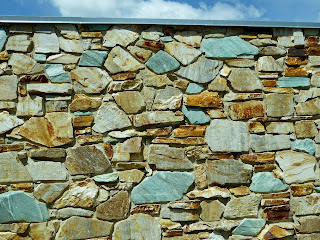 You probably remember this place from American history classes. Golden Spike National Historic Site at Promontory Summit, Utah, is where the last spike was driven for the transcontinental railroad. This was a really big deal in 1869, not much going on there now.
You probably remember this place from American history classes. Golden Spike National Historic Site at Promontory Summit, Utah, is where the last spike was driven for the transcontinental railroad. This was a really big deal in 1869, not much going on there now. We drove across the tracks, then went to the Visitor Center. There’s a plaque out front with some gooey language about the event. They used rocks from a quarry near Park Valley, Utah, for the building. I was fascinated with the green stone—it’s cupreous (copper) quartzite.
We drove across the tracks, then went to the Visitor Center. There’s a plaque out front with some gooey language about the event. They used rocks from a quarry near Park Valley, Utah, for the building. I was fascinated with the green stone—it’s cupreous (copper) quartzite.
Inside, the Ranger showed us the difference in the size of the
railroad spikes between 1869 and 1969. It's a cool display, but I'm not quite sure what the point of this was. I don't think it was simply that it would take more gold for a spike now. Probably had something to do with the weight of the trains, but I'm not really sure. George probably paid more attention than I did...maybe you could ask him.
We watched the video.
Wandered around the museum. Learned more than I expected. I’ll share...
Both the Central Pacific Railroad from California and the
Union Pacific Railroad from New York broke ground in 1863 to join the country with a transcontinental railroad.
They had to survey and grade as well as build tunnels and trestles
before they could lay any track at all. When
they laid track, they got some pretty impressive subsidies from Uncle Sam. (Please
don’t think that CP’s Leland Stanford and UP’s Thomas Durant were doing this
for a publicity gimmick. This was for big profit!)
Supplies were a logistical nightmare because it took 8 flatcars of material for each mile of track. After the Civil war, they really started going—at a whopping 2-5 miles a day on flat ground. Sometimes work parties on the Plains were raided by the Sioux and Cheyenne. The Central Pacific had to have every rail, spike and locomotive 15,000 miles around Cape Horn! (The mind boggles...)
Supplies were a logistical nightmare because it took 8 flatcars of material for each mile of track. After the Civil war, they really started going—at a whopping 2-5 miles a day on flat ground. Sometimes work parties on the Plains were raided by the Sioux and Cheyenne. The Central Pacific had to have every rail, spike and locomotive 15,000 miles around Cape Horn! (The mind boggles...)
By mid-1868 Central Pacific had laid 200 miles of track
across the Sierras—and Union Pacific had laid 700 miles from Omaha. As they got
closer together, greed got in the way of common sense, and the race was on to
grade more miles for land subsidies. One
day in April 1869 set a world record.
They actually passed each other on parallel grades and went 200 miles beyond their railheads. Congress finally put a stop to that
nonsense, drew a line in the sand and told them to meet up at Promontory Point.
This painting shows the way it looked for the ceremony. That’s the Jupiter from Central Pacific on the left and the Union Pacific‘s No. 119 on the right. (There's better pictures of the trains below.)
They left a single rail gap for the symbolic Golden Spike,
then the iron one was driven. After that I
assume the locomotives backed up.
This is a replica of the ceremonial Golden Spike. The original is at the museum at Stanford
University. (Leland Stanford, remember?)
Views of the track, both directions--just to show you that it really is out in the middle of nowhere!
On the anniversary of the event, they re-enact it with the locomotives nose to nose on the track.
On the anniversary of the event, they re-enact it with the locomotives nose to nose on the track.
The Ranger gave us directions to the Engine House, where
they keep the replica locomotives. (Out
of the parking lot, down to the tracks, hang a right and at the house keep to
the left at the fork...) The tourist season starts Memorial Day weekend, so the crews inside were busy painting the trim and polishing the brass, getting the engines all spiffed up for the summer season.
They had volunteers from Americorps and I got a chance to talk to
some of the kids. Americorps is sort of like the Peace Corps, only domestic rather than international. They volunteer for national and community service and
get sent all over the country to do all sorts of seasonal work at parks and other state or national facilities. Pretty cool thing to do. Wonder if they get college credit for it?
More pictures here: Golden Spike NHS











Post a comment.
Post a Comment
Please leave comments here: